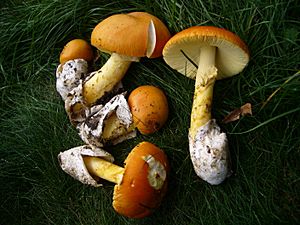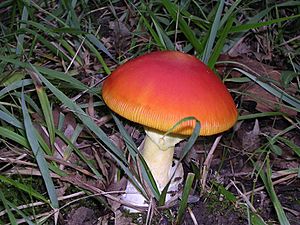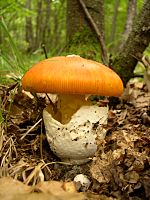Caesar's mushroom facts for kids
Quick facts for kids Caesar's mushroom |
|
|---|---|
 |
|
| Conservation status | |
| Scientific classification | |
| Genus: |
Amanita
|
| Species: |
caesarea
|
| Synonyms | |
|
|
| Amanita caesarea | |
|---|---|
| Mycological characteristics | |
| gills on hymenium | |
| cap is convex | |
| hymenium is free | |
| stipe has a ring and volva | |
| spore print is white | |
| ecology is mycorrhizal | |
| edibility: choice but not recommended | |
The Caesar's mushroom (scientific name: Amanita caesarea) is a very special and highly valued edible mushroom. It grows naturally in southern Europe and North Africa. This mushroom was a favorite food of the early rulers of the Roman Empire.
It has a bright orange cap, yellow gills, and a yellow stem. The Romans loved this mushroom. They called it Boletus, which is now the name for a different type of fungus. Even though it's delicious, the Caesar's mushroom is related to some very dangerous mushrooms. These include the poisonous fly agaric and the deadly death cap and destroying angels. Always be careful and never eat wild mushrooms unless an expert says they are safe!
About Its Name
The Caesar's mushroom was first described by a scientist named Giovanni Antonio Scopoli in 1772. He called it Agaricus caesareus. Later, in 1801, another scientist named Persoon placed it in the Amanita group.
Its common name, "Caesar's mushroom," comes from the Roman emperors. They were called Caesar and loved this mushroom. It was a personal favorite of the Roman emperor Claudius. The Romans called it Bōlētus. Many modern names for this mushroom also show its royal connection. For example, in English, it's "royal amanita." In Italian, it's ovolo, meaning "little egg," because it looks like an egg when it's very young.
Similar mushrooms grow in other parts of the world. For example, Amanita hemibapha is found in India and the Himalayas. Some similar types are also found in North America. People eat Amanita jacksonii in North America, and it seems to be safe.
What It Looks Like
This mushroom has a cap that is orange-red. When it's young, the cap is shaped like a hemisphere (half a ball). Then it becomes convex (curved like a dome), and finally it flattens out. The cap is smooth and can grow up to 15 centimeters (about 6 inches) wide. Sometimes it can even reach 20 centimeters (about 8 inches)!
The gills under the cap are pale to golden yellow. The stem is also yellow and shaped like a cylinder. It can be 8 to 15 centimeters (about 3 to 6 inches) tall. Around the stem, there's a loose ring. At the very bottom of the stem, there's a greyish-white cup-like structure. This is called a volva, and it's a leftover from when the mushroom was very young. The spores of this mushroom are white.
It's very important not to confuse the Caesar's mushroom with the poisonous fly agaric (Amanita muscaria). The fly agaric usually has a red cap with white spots. However, these spots can fall off as it gets older. Also, its bright red color can fade to a yellowish-orange. A key difference is that the fly agaric always has white gills and a white stem, not yellow ones.
Where It Grows
The Caesar's mushroom is found in southern Europe and North Africa. It's especially common in the hills of northern Italy. Some people think the Roman armies might have brought it north of the Alps. This is because it's often found along old Roman roads.
You can also find this mushroom in places like the Balkans, Hungary, India, Iran, and China. Even though it's not known to grow naturally in the United States and Canada, it has been found in Mexico.
In Europe, the Caesar's mushroom mostly grows in oak forests. It can be found alone or in groups from early summer to mid-autumn. In warmer places like Mexico, it grows in oak, pine, or fir forests high up in the mountains. It prefers flat areas but can also grow on slopes.
This mushroom is considered special. It is protected by law in several countries, including Croatia, Slovenia, the Czech Republic, and Germany. It is also listed in the Red Data book of Ukraine, which means it's a species that needs protection.
Edibility
The Caesar's mushroom is a very popular and delicious mushroom in Europe. People traditionally gather and eat it in Italy. There, it's known as ovolo or ovolo buono, meaning "good egg." In Mexico, people also eat it. They sometimes roast it with a special herb called epazote.
It's important to remember that wild mushrooms can sometimes absorb heavy metals from the soil. So, even though the Caesar's mushroom is edible, it's always best to be cautious. Only eat wild mushrooms if they have been clearly identified as safe by an expert.
See also
 In Spanish: Oronja para niños
In Spanish: Oronja para niños
- List of Amanita species
Gallery








